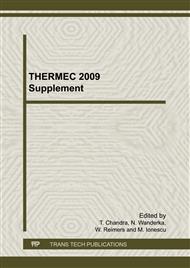p.437
p.443
p.449
p.455
p.461
p.467
p.473
p.479
p.485
A Study on Similar and Dissimilar Linear Friction Welds of 2024 Al Alloy and 2124Al/SiCP Composite
Abstract:
The aim of the present work is to evaluate the possibility of using the Linear Friction Welding (LFW) technique to produce similar and dissimilar joints between a 2024 Al alloy and a 2124Al/25vol.%SiCP composite. In this solid state joining process the bonding of two flat edged components is achieved through frictional heating induced by their relative reciprocating motion, under an axial compressive force. Microstructural characterization of the welds was carried out by optical and scanning electron microscopy, to investigate the effect of LFW both on the aluminium alloy matrix and the reinforcement particles. The mechanical behaviour of the welded specimens was studied by means of hardness and tensile tests. The mechanisms of failure were investigated by SEM analyses of the fracture surfaces. LFW joints in MMCs resulted substantially defect free, with a uniform particle distribution, while a partial lack of bonding at the corners was observed in the others welds. The hardness decreased by approximately 10% in the welded zone, with some data fluctuations due to the complex microstructural modifications introduced by the LFW process. The joint efficiency, evaluated in respect to the UTS, was 90% for the Al alloy joints and 80% for the MMC joints. A decrease in the elongation to failure was measured in all the LFW specimens, probably related to the orientation of the plastic flow in the TMAZ, where the fracture generally occurred.
Info:
Periodical:
Pages:
461-466
Citation:
Online since:
January 2010
Price:
Сopyright:
© 2010 Trans Tech Publications Ltd. All Rights Reserved
Share:
Citation:


